Vampire Circus (1972)
Directed by: Robert Young
Written by: George Baxt, Judson Kinberg
Starring: Adrienne Corri, Anthony Corlan, John Moulder-Brown, Laurence Payne
UK
AVAILABLE ON BLU-RAY AND DVD
RUNNING TIME: 87 mins
REVIEWED BY: Dr Lenera, Official HCF Critic
Schoolmaster Albert Muller leads the villagers of Stetl, Serbia, to invade the castle of Count Mitterhaus, a vampire responsible for the disappearances of children. He’s also enslaved Muller’s wife Anna. Staked, the dying Count curses the villagers, vowing that their children will die to give him back his life, then tells Anna to find his cousin Emil at the Circus of Night, who then escapes through an underground tunnel as the villagers destroy the castle. Fifteen years later, Stetl is being ravaged by a plague and blockaded by the authorities of neighboring towns, with men ready to shoot anyone who tries to leave. Then a travelling circus calling itself the Circus of Night arrives, and the villagers enjoy it, not knowing who a certain Emil, one of their performers, actually is….
Influenced as much by Something Wicked This Way Comes as the usual sources, Vampire Circus was one of several Hammers I reviewed previously for this website, and was certainly the one I was looking forward to revisiting most. “What’s happened to the great vampire/Dracula subjects we used to make without all this unnecessary gore and sick-making material”? said Hammer boss Sir James Carreras after reading through the Vampire Circus script, and there’s no doubt that this is probably the bloodiest and most daring Hammer film of them all – few modern horror fans will get bothered by the gore, but they might at least be surprised by the hints of bestiality and especially paedophilia. I also think it’s Hammer’s best vampire film after their first three Draculas. That may seem to be a ridiculous statement, but hopefully if you read on you’ll understand why I feel that way, and you may have to at least admit that it’s one of their most intriguing. Of course you probably can’t go wrong with the great idea of a circus of vampires anyway, but this movie, despite looking very cheap in places like most of the ’70’s Hammers [Hands Of The Ripper and Countess Dracula excepted] also has a really well achieved dark fairy tale feel and even a sense of wonderment while maintaining possibly the fastest pace of any Hammer film. It only really goes significantly downhill in the final quarter where, as with Blood From The Mummy’s Tomb, it’s patently obvious that the film wasn’t finished and that bits are missing.
George Baxt’s treatment was turned into a screenplay by Judson Kinberg despite Carreras saying that half the script, if filmed, would probably end up on the cutting room floor what with the new head of the UK censors the BBFC Stephen Murphy having quickly got a reputation of being very tough. Co-financed by independent producer Wilbur Stark, Vampire Circus was the last Hammer film Rank were involved with as distributors. Laurence Payne had to replace Anton Rogers as Mueller just before shooting as Rogers had stomach pains. Filmed at Black Park and Pinewood on sets left over from Twins Of Evil, it was directed by Robert Young who was something of a perfectionist and fell behind schedule. Once the five week shooting period was over, he had to edit the film together as best he could with several scenes, including some transformation sequences, un-shot. The BBFC required many cuts but after much to-ing and fro-ing only a graphic face stabbing was totally removed. Other conscientious material – the erotic circus dance, forest panther attack, mutilated panther victims and a burnt face – was just shortened. In 2000, most of the cut material was restored for DVD but the face stabbing shot couldn’t be found. On the other hand the US version totally removed the dance and most of the gore to get – for some reason – a ‘PG’ rating. The film was double billed with Countess Dracula but the release did poor business on both sides of the Atlantic. There was no doubt that Hammer were in serious decline commercially despite their best efforts.
The stunning pre-title prologue lasts ten minutes or so and functions as a great little film in its own right. A young girl is led into the castle by Anna where Mitterhaus suddenly appears in front of a painting of himself and disturbingly caresses her hair before biting her. The latter isn’t really shown, but Anna is clearly turned on by the act and she and Mitterhaus then have sex. This one lets you know it’s going to be a little ‘dodgier’ than usual right away, and then we get a bloody fight before Mitterhaus is killed and Anna runs the ‘gauntlet’ of being beaten with belts. Upon first viewing I really wondered if the rest of the film would live up to this opening, but it mostly does until the final act – though you have to wonder how, after we’ve had a nice title sequence showing the passage of fifteen years, this circus that visits Stetl is able to get past border guards even if it contains several vampires, and why the villagers turn out in droves for this potentially plague-spreading attraction. And, as it soon becomes apparent that these odd folk are on a mission to revive Mitterhaus using the blood of victims, why do they draw so much attention to themselves? Still, the early sequences of the circus [which utilised some real circus performers] playing to the villagers have a striking sense of wonder to them despite the painfully obvious and very limited set. A boy and a girl jump into the air and become bats, and a panther becomes a man, in moments achieved by simple jump cuts and which are the better for it. Then a leopard woman does a highly sexual dance with a man with a whip, replete with a cutaway to what seems to be an aroused tiger and the woman having a plainly visible, though painted, vagina! All this occurs under a creepy dwarf ringmaster who has a horrible laugh and with the occasional interventions of a strongman, while a watching chimpanzee just constantly chuckles.
It’s all quite uncanny but rather sexy and even poetic. We share the curiosity of the villagers and even start to like these exciting, very sensual folk who are a lot more interesting than the dull, uptight villagers – well, at least until they start biting children in the neck. The twins lure two kids into a room of mirrors, and as the camera starts to spin round them and the children are hypnotised by the twins who move closer and closer to bite them, there’s a real sense of transgressive horror, without actually crossing the line into sickness – though I doubt that any modern vampire film would have the guts to have the vampires hypnotise and kill children on screen. It’s quite frightening, and come to think of so is an earlier scene in the same place where the Burgomaster sees in one of the mirrors a reflection of Mitterhouse biting him. Perhaps the fascinating idea of vampire magic could have been developed a bit, and there’s almost too much else going on for the short running time to contain, such as the Burgomaster’s daughter running off to sleep with Emil [remember he’s able to turn into a panther], and Emil in panther form killing some villagers trying to flee the village and later some students in a scene which occurs totally off-screen – but dull this film certainly isn’t. The most obvious example of un-shot footage could be when Mueller recognises the gypsy woman as his old girlfriend Anna [despite being played by a different actress]. You’d think this would be a dramatic scene, but the moment is totally thrown away. And one wonders if the climax was hastily rewritten to replace a longer sequence of events. I have to laugh when Muller pulls the stake out of Mitterhouse to kill his attacker and then Mitterhaus is himself only alive for under a minute before being killed again, though I do like it when nearly everyone dies at the end of one of these films, it’s a nice change to the ‘good totally triumphant over evil’ cliche.
Some drops of blood dripping onto Mitterhaus just look silly, and a shakycam panther attack comprised largely of shots of a mask might be the film’s low point. Maybe this was a scene that was unfinished and they unwisely decided to try and piece it together anyway. However, the quick shots of mutilated bodies afterwards are gratifyingly gruesome without dwelling on the carnage in the way so many modern horror films do so. The spurting blood, vampire bites, a huge cross impaling a vampire, and even some front projected bats [Hammer finally realising that their Woolworths toy bats on strings just weren’t cutting it] all look pretty good, and I love the way that these vampires lift their heads back in a most theatrical fashion and snarl before biting their victims – though it does seem that Anthony Corlan [almost unrecognisable from the young hero of Taste The Blood Of Dracula], one of the most facially animated vampires in movie history, is having trouble with his very long fangs at times. Young stages many of the scenes in an almost ritualistic, even slightly Japanese, fashion which possibly lessens the unease that some viewers may feel with certain aspects. It’s such a shame that he otherwise did mainly TV stuff and never made another horror movie again, because he showed with Vampire Circus that had a real feel for the genre and an ability to create quite a rich, magical atmosphere despite having limited means at his disposal.
John Moulder-Brown is a rather wet hero, which is something you could say about many of Hammer’s young leading men, but usually that fact wasn’t a big deal if Christopher Lee or Peter Cushing were also in the movie. Thorley Walters is appropriately cast as the slightly bumbling Burgomaster, Robert Tayman barely gets a chance to make an impression as the ’70’s rock star-style Mitterhaus, and Dave Prowse is able to show his face properly as the strongman unlike in his two appearances as Frankenstein Monsters. David Whitaker provides a terrific music score, right from the beginning where his scoring of the opening is a great little mini-symphony in its own right as well as musically telling the story, linking together several different moods from the dramatic waltz accompanying the sex of Mitterhaus and Anna to the sad piece evoking the sorrow and shame of Anna and Muller. His main theme, mostly used for Mitterhaus, is almost a variation on a James Bernard theme for Dracula Has Risen From The Grave. It’s certainly not all bombast – there’s also the mystical flute patterns for the bat transformation show and that irritatingly memorable circus waltz. Vampire Circus has a great deal to recommend it and parts of it are magnificent. It’s just a shame that Young wasn’t allowed to complete it, but we were still left with a minor vampire classic that tries to do some new stuff with our fanged friends while still giving us much of what we want and expect.

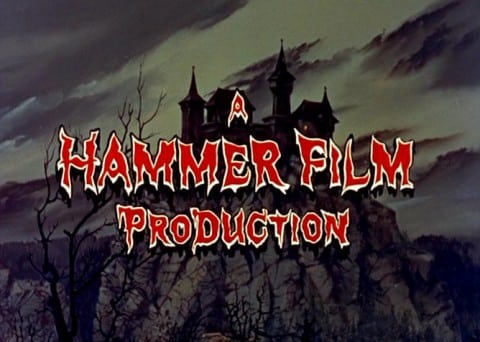
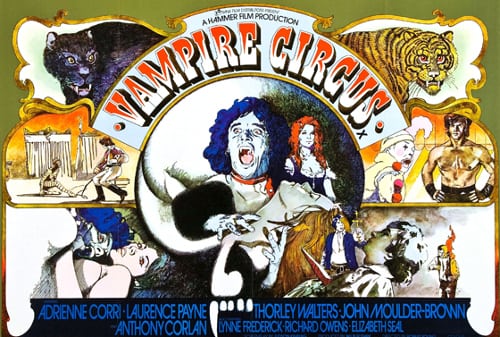
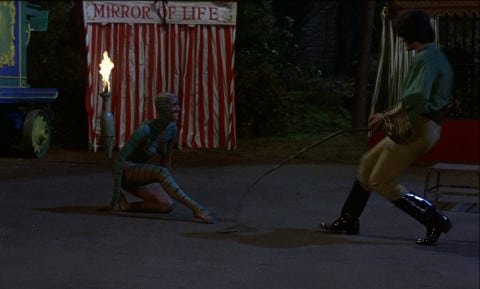





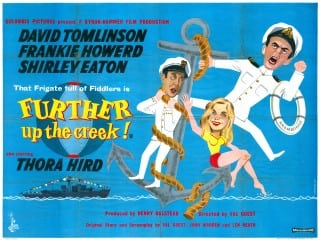

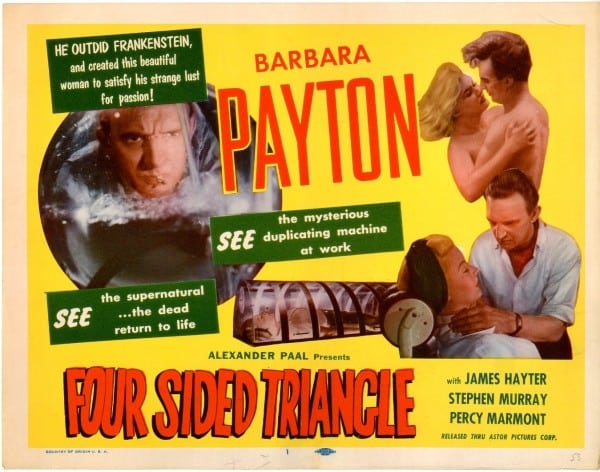
Be the first to comment